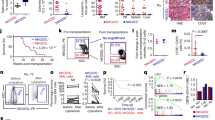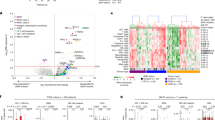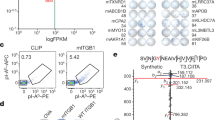Abstract
Therapeutic effects of haematopoietic stem cell transplantation are not limited to maximal chemoradiotherapy and subsequent bone marrow regeneration, but include specific as well as unspecific immune reactions known as graft-versus-leukaemia (GvL) effects. Specific immune reactions are likely to be particularly relevant to the long-term treatment of diseases, such as chronic myeloid leukaemia (CML), in which residual cells may remain quiescent and unresponsive to cytotoxic and molecular therapies for long periods of time. Specific GvL effects result from the expression on leukaemic cells of specific tumour-associated antigens (TAAs) in the context of HLA proteins. As human leukocyte antigen (HLA) types vary widely, the development of broadly applicable tumour vaccines will require the identification of multiple TAAs active in different HLA backgrounds. Here, we describe the identification of NM23-H2 as a novel HLA-A32-restricted TAA of CML cells and demonstrate the presence of specifically reactive T cells in a patient 5 years after transplantation. As the NM23 proteins are aberrantly expressed in a range of different tumours, our findings suggest potential applications beyond CML and provide a new avenue of investigation into the molecular mechanisms underlying CML.
This is a preview of subscription content, access via your institution
Access options
Subscribe to this journal
Receive 12 print issues and online access
$259.00 per year
only $21.58 per issue
Buy this article
- Purchase on Springer Link
- Instant access to full article PDF
Prices may be subject to local taxes which are calculated during checkout







Similar content being viewed by others
References
Gratwohl A, Brand R, Apperley J, Crawley C, Ruutu T, Corradini P et al. Allogeneic hematopoietic stem cell transplantation for chronic myeloid leukemia in Europe 2006: transplant activity, long-term data and current results. An analysis by the Chronic Leukemia Working Party of the European Group for Blood and Marrow Transplantation (EBMT). Haematologica 2006; 91: 513–521.
Martinelli G, Iacobucci I, Soverini S, Cilloni D, Saglio G, Pane F et al. Monitoring minimal residual disease and controlling drug resistance in chronic myeloid leukaemia patients in treatment with imatinib as a guide to clinical management. Hemat Oncol 2006; 24: 196–204.
Ohno R . Treatment of chronic myeloid leukemia with imatinib mesylate. Int J Clin Oncol 2006; 11: 176–183.
Holtz MS, Bhatia R . Effect of imatinib mesylate on chronic myelogenous leukemia hematopoietic progenitor cells. Leuk Lymphoma 2004; 45: 237–245.
Holtz MS, Forman SJ, Bhatia R . Nonproliferating CML CD34+ progenitors are resistant to apoptosis induced by a wide range of proapoptotic stimuli. Leukemia 2005; 19: 1034–1041.
Copland M, Jorgensen HG, Holyoake TL . Evolving molecular therapy for chronic myeloid leukaemia—are we on target? Hematology 2005; 10: 349–359.
Hogan WJ, Deeg HJ . Stem cell transplantation: graft-mediated antileukemia effects. Methods Mol Med 2005; 109: 421–444.
Cohen CJ, Sarig O, Yamano Y, Tomaru U, Jacobson S, Reiter Y . Direct phenotypic analysis of human MHC class I antigen presentation: visualization, quantitation, and in situ detection of human viral epitopes using peptide-specific, MHC-restricted human recombinant antibodies. J Immunol 2003; 170: 4349–4361.
Romani N, Reider D, Heuer M, Ebner S, Kämpgen E, Eibl B et al. Generation of mature dendritic cells from human blood: an improved method with special regard to clinical applicability. J Immunol Methods 1996; 196: 137–151.
Ennis PD, Zemmour J, Salter RD, Parham P . Rapid cloning of HLA-A, B cDNA by using the polymerase chain reaction: frequency and nature of errors produced in amplification. Proc Natl Acad Sci USA 1990; 87: 2833–2837.
Chomczynski P, Sacchi N . Single-step method of RNA isolation by acid guanidinium thiocyanate-phenol-chloroform extraction. Anal Biochem 1987; 162: 156–159.
Gabert J, Beillard E, van der Velden VH, Bi W, Grimwalde D, Pallisgaard N et al. Standardization and quality control studies of ‘real-time’ quantitative reverse transcriptase polymerase chain reaction of fusion gene transcripts for residual disease detection in leukemia—a Europe Against Cancer program. Leukemia 2003; 17: 2318–2357.
Lennerz V, Fatho M, Gentilini C, Frye RA, Lifke A, Ferel D et al. The response of autologous T cells to a human melanoma is dominated by mutated neoantigens. Proc Natl Acad Sci USA 2005; 102: 16013–16018.
Barnstable CJ, Bodmer WF, Brown G, Galfre G, Milstein C, Williams AF et al. Production of monoclonal antibodies to group A erythrocytes, HLA and other human cell surface antigens—new tools for genetic analysis. Cell 1978; 14: 9–20.
Rebai N, Malissen B . Structural and genetic analyses of HLA class I molecules using monoclonal xenoantibodies. Tissue Antigens 1983; 22: 107–117.
Berger AE, Davis JE, Cresswell P . Monoclonal antibody to HLA-A3. Hybridoma 1982; 1: 87–90.
Radka SF, Kostyu DD, Bernard D, Amos B . A monoclonal antibody directed against the HLA-Bw6 epitope. J Immunol 1982; 128: 2804–2806.
Postel EH, Berberich SJ, Flint SJ, Ferrone CA . Human c-myc transcription factor PuF identified as nm23-H2 nucleoside diphosphate kinase, a candidate suppressor of tumor metastasis. Science 1993; 261: 428–429.
Van den Eynde BJ, van der Bruggen P . T cell defined tumor antigens. Curr Opin Immunol 1997; 9: 684–693.
Harrer T, Harrer E, Kalams SA, Barbosa P, Trocha A, Johnson RP et al. Cytotoxic T lymphocytes in asymptomatic long-term nonprogressing HIV-1 infection. J Immunol 1996; 156: 2616–2623.
Steeg PS, Bevilacqua G, Kopper L, Thorgeirsson UP, Talmadge JE, Liotta LA et al. Evidence for a novel gene associated with low tumor metastatic potential. J Natl Cancer Inst 1988; 80: 200–204.
Roymans D, Willems R, Van Blockstaele DR, Slegers H . Nucleoside diphosphate kinase (NDPK/NM23) and the waltz with multiple partners: possible consequences in tumor metastasis. Clin Exp Metastasis 2002; 19: 465–476.
Aryee DN, Simonitsch I, Mosberger I, Kos K, Mann G, Schlogl E et al. Variability of nm23-H1/NDPK-A expression in human lymphomas and its relation to tumour aggressiveness. Br J Cancer 1996; 74: 1693–1698.
van Noesel MM, Versteeg R . Pediatric neuroblastomas: genetic and epigenetic ‘danse macabre’. Gene 2004; 325: 1–15.
Hartsough MT, Steeg PS . Nm23/Nucleoside diphosphate kinase in human cancers. J Bioenerg Biomem 2000; 32: 301–307.
Kauffman EC, Robinson VL, Stadler WM, Sokoloff MH, Rinker-Schaeffer CW . Metastasis suppression: the evolving role of metastasis suppressor genes for regulating cancer cell growth at the secondary site. J Urol 2003; 169: 1122–1133.
Okabe-Kado J, Kasukabe T . Physiological and pathological relevance of extracellular NM23/NDP kinases. J Bioenerg Biomem 2003; 35: 89–93.
Okabe-Kado J, Kasukabe T, Honma Y . Differentiation inhibitory factor Nm23 as a prognostic factor for acute myeloid leukemia. Leuk Lymphoma 1998; 32: 19–28.
Wakimoto N, Yokoyama A, Mukai Y, Kuwada N, Yamashita T, Matsumura T et al. Elevated expression of differentiation inhibitory factor nm23 mRNA in monoblastic crisis of a patient with chronic myelogenous leukemia. Int J Hematol 1998; 67: 313–318.
Yokoyama A, Okabe-Kado J, Wakimoto N, Kobayashi H, Sakashita A, Maseki N et al. Evaluation by multivariate analysis of the differentiation inhibitory factor nm23 as a prognostic factor in acute myelogenous leukemia and application to other hematologic malignancies. Blood 1998; 91: 1845–1851.
Postel EH . Multiple biochemical activities of NM23/NDP kinase in gene regulation. J Bioenerg Biomem 2003; 35: 31–40.
Postel EH, Berberich SJ, Rooney JW, Kaetzel DM . Human NM23/nucleoside diphosphate kinase regulates gene expression through DNA binding to nuclease- hypersensitive transcriptional elements. J Bioenerg Biomem 2000; 32: 277–284.
Godfried MB, Veenstra M, v Sluis P, Boon K, v Asperen R, Hermus MC et al. The N-myc and c-myc downstream pathways include the chromosome 17q genes nm23-H1 and nm23-H2. Oncogene 2002; 21: 2097–2101.
Gopal V, Kadam P, Preisler H, Hulette B, Li YQ, Steele P et al. Abnormal regulation of the myc gene in myeloid leukemia. Med Oncol Tumor Pharmacother 1992; 9: 139–147.
Handa H, Hegde UP, Kotelnikov VM, Mundle SD, Dong LM, Burke P et al. BCL-2 and C-MYC expression, cell cycle kinetics and apoptosis during the progression of chronic myelogenous leukemia from diagnosis to blastic phase. Leuk Res 1997; 21: 479–489.
Gupta S, Seth A, Davis RJ . Transactivation of gene expression by Myc is inhibited by mutation at the phosphorylation sites Thr-58 and Ser-62. Proc Natl Acad Sci USA 1993; 90: 3216–3220.
Vervoorts J, Lüscher-Firzlaff J, Lüscher B . The ins and outs of MYC regulation by posttranslational mechanisms. J Biol Chem 2006; 281: 34725–34729.
Joosten M, Blázquez-Domingo M, Lindeboom F, Boulmé F, Van Hoven-Beijen A, Habermann B et al. Translational control of putative protooncogene Nm23-M2 by cytokines via phosphoinositide 3-kinase signaling. J Biol Chem 2004; 279: 38169–38176.
Weinzierl AO, Lemmel C, Schoor O, Müller M, Krüger T, Wernet D et al. Distorted relation between mRNA copy number and corresponding major histocompatibility complex ligand density on the cell surface. Mol Cell Proteomics 2007; 6: 102–113.
Brauer KM, Werth D, von Schwarzenberg K, Bringmann A, Kanz L, Grünebach F et al. BCR-ABL activity is critical for the immunogenicity of chronic myelogenous leukemia cells. Cancer Res 2007; 67: 5489–5497.
Scheich F, Duyster J, Peschel C, Bernhard H . The immunogenicity of Bcr-Abl-expressing dendritic cells is dependent on the Bcr-Abl kinase activity and dominated by Bcr-Abl-regulated antigens. Blood 2007; 110: 2556–2560.
Bocchia M, Korontsvit T, Xu Q, Mackinnon S, Young Yang S, Sette A et al. Specific human cellular immunity to bcr-abl oncogene-derived peptides. Blood 1996; 87: 3587–3592.
Rusakiewicz S, Molldrem JJ . Immunotherapeutic peptide vaccination with leukemia-associated antigens. Curr Opin Immunol 2006; 18: 599–604.
Bocchia M, Abruzzese E, Forconi F, Ippoliti M, Trawinska MM, Pirrotta MT et al. Imatinib does not impair specific antitumor T-cell immunity in patients with chronic myeloid leukemia. Leukemia 2006; 20: 142–143.
Barrett AJ, Rezvani K . Translational mini-review series on vaccines: peptide vaccines for myeloid leukaemias. Clin Exp Immunol 2007; 148: 189–198.
Schmitt M, Li L, Giannopoulos K, Chen J, Brunner C, Barth T et al. Chronic myeloid leukemia cells express tumor-associated antigens eliciting specific CD8þ T-cell responses and are lacking costimulatory molecules. Exp Haematol 2006; 34: 1709–1719.
Dermime S, Gilham DE, Shaw DM, Davidson EJ, Meziane EK, Armstrong A et al. Vaccine and antibody-directed T cell tumour immunotherapy. Biochimica Et Biophysica Acta 2004; 1704: 11–35.
Acknowledgements
We thank A Jilo for technical assistance. This work was supported by Grant 70-3344 (TP IV C/D) from the Deutsche Krebshilfe and by Grant D08 from the IZKF Leipzig to DN.
Author information
Authors and Affiliations
Corresponding author
Rights and permissions
About this article
Cite this article
Tschiedel, S., Gentilini, C., Lange, T. et al. Identification of NM23-H2 as a tumour-associated antigen in chronic myeloid leukaemia. Leukemia 22, 1542–1550 (2008). https://doi.org/10.1038/leu.2008.107
Received:
Revised:
Accepted:
Published:
Issue Date:
DOI: https://doi.org/10.1038/leu.2008.107
Keywords
This article is cited by
-
Metabolic remodeling of pyrimidine synthesis pathway and serine synthesis pathway in human glioblastoma
Scientific Reports (2022)
-
Extracellular NME proteins: a player or a bystander?
Laboratory Investigation (2018)
-
Regulatory functions of Nm23-H2 in tumorigenesis: insights from biochemical to clinical perspectives
Naunyn-Schmiedeberg's Archives of Pharmacology (2015)
-
New insights into antigen specific immunotherapy for chronic myeloid leukemia
Cancer Cell International (2012)



